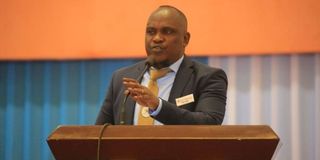Tanzania rallies for African collaboration on mineral processing to maximize resource benefits

CEO of the State Mining Corporation (Stamico), Dr Venance Mwasse
What you need to know:
Representing the Minister of Minerals, Mr Anthony Mavunde, at the "Ministerial Session" of the Africa Critical Minerals Summit in Cape Town, South Africa, on Thursday, November 7, 2024, CEO of the State Mining Corporation (Stamico), Dr Venance Mwasse, spoke of the need to conduct cost-benefit analyses to determine the ideal locations for such facilities across the continent.
Cape Town. Tanzania has called for increased collaboration among African nations to establish processing and refining facilities on the continent to ensure maximum benefits from Africa's vast natural resources.
Representing the Minister of Minerals, Mr Anthony Mavunde, at the "Ministerial Session" of the Africa Critical Minerals Summit in Cape Town, South Africa, on Thursday, November 7, 2024, CEO of the State Mining Corporation (Stamico), Dr Venance Mwasse, spoke of the need to conduct cost-benefit analyses to determine the ideal locations for such facilities across the continent.
“For example, the upcoming Kabanga Nickel multi-metal smelter in Kahama, Tanzania, will enable neighbouring countries such as Burundi and the Democratic Republic of Congo to process their minerals locally, fostering regional prosperity and maximizing the benefits derived from these resources,” Dr Mwasse said. “Strong partnerships among African nations are crucial for making this vision a reality.”
Dr Mwasse also highlighted Tanzania’s growing role as a global leader in the mining of minerals critical for modern energy production and technological advancement. These include graphite, nickel, cobalt, lithium, rare earth elements, and niobium. According to Dr Mwasse, Tanzania is on track to become a global powerhouse in graphite mining.
Citing a recent World Bank report and data from the U.S. Geological Survey, Dr Mwasse said that by 2050, Tanzania is projected to rank sixth globally and third in Africa in graphite production, with Mozambique and Madagascar leading in Africa.
Dr Mwasse also presented Tanzania’s Mining Vision 2030, which aims to attract investment by conducting extensive geological research in areas where data is currently limited. This will help "de-risk" the mining sector, boosting investor confidence.
“One key initiative involves expanding high-resolution airborne surveys from the current 16 percent coverage to 50 percent by 2030. This will improve exploration accuracy and help build investor confidence,” he said.
Furthermore, Tanzania is strengthening Stamico’s role by issuing exploration licenses and conducting preliminary research to reduce investor start-up times and minimize risks associated with unproven resources. Dr Mwasse concluded by urging other African nations to strengthen their state-owned mining corporations to drive critical mineral development and enhance national benefits.
“By doing so, we can increase Africa’s position in the global mining sector,” Dr Mwasse added.





